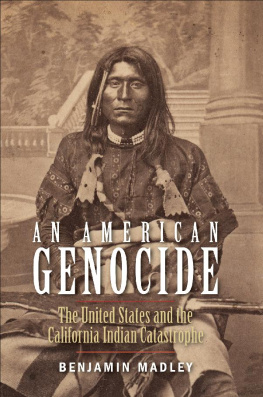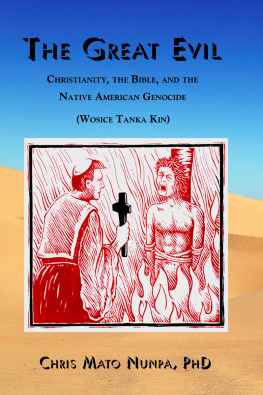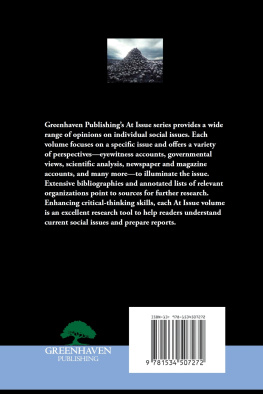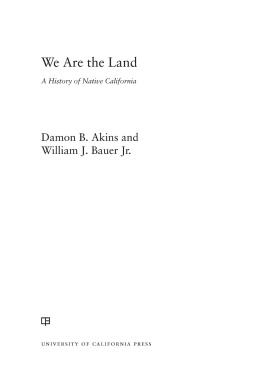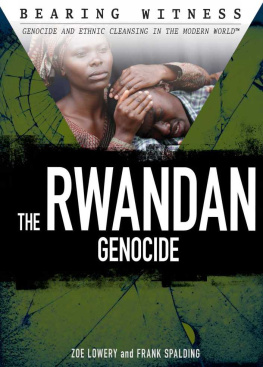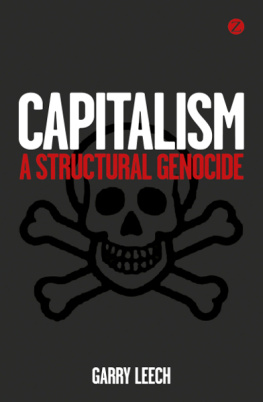
ABBREVIATIONS
|
|---|
BANC | Bancroft Library, University of California, Berkeley |
BLYU | Beinecke Library, Yale University, New Haven, Connecticut |
CG | Congressional Globe |
CSA | California State Archives, Sacramento |
CSL | California State Library, Sacramento |
DAC | Daily Alta California (San Francisco) |
DEB | Daily Evening Bulletin (San Francisco) |
HL | Huntington Library |
HT | Humboldt Times |
IWP | California Adjutant Generals Office, Military Department, Adjutant General, Indian War Papers F3753 |
LAS | Los Angeles Star |
MLRV | Martial Law in Round Valley, Mendocino Co., California, The Causes Which Led To That Measure, The Evidence, As Brought out by a Court of Investigation ordered by Brig. Gen. G. Wright, Commanding U.S. Forces on the Pacific (Ukiah City, 1863) |
MMR | California, Majority and Minority Reports of the Special Joint Committee on the Mendocino War (Sacramento, 1860) |
NARA | US National Archives and Records Administration |
RG75, M234 | US National Archives and Records Administration, Letters Received by the Office of Indian Affairs, 182480 |
SDU | Sacramento Daily Union |
USOIA | US Office of Indian Affairs |
WOR | US War Department, The War of the Rebellion: A Compilation of the Official Records of the Union and Confederate Armies. 4 series, 130 volumes. Series 1, volume 50, part 1 [WOR 1:50:1]; Series 1, volume 50, part 2 [WOR 1:50:2]; Series 1, volume 52, part 2 [WOR 1:52:2]. |

ACKNOWLEDGMENTS
At a place called Indian Ferry, not far from where my familys log cabin now stands, whites massacred at least thirty Shasta Indians in the spring of 1852. The victims had not attacked whites. Nor had they stolen from them. Whites killed them near the banks of the Klamath River merely because they were Indians. Few people have heard of this massacre or the many others like it. Yet there were scores of such atrocities. Hundreds of Indian-killing sites stain California from the fog-bound northwestern redwood coast to the searing southeastern deserts. Individuals, private groups, state militiamen, and US Army soldiers carried out these killings, ostensibly to protect non-Indians or to punish Indians for suspected crimes. In fact, the perpetrators often sought to annihilate Californias indigenous peoples between 1846 and 1873.
The story of the California Indian catastrophe is almost unrelentingly grim, which helps to explain why relatively little has been written about it, at least compared to other genocides. Until now, no one has written a comprehensive, year-by-year history of the cataclysm. It is, nevertheless, important history, for both California Indians and non-Indians. In researching and writing this book, I received guidance and support from many people and institutions.
Fellow scholars helped shape my ideas, methods, and writing. Gary Clayton Anderson, Ute Frevert, Albert Hurtado, Karl Jacoby, Adam Jones, Paul Kennedy, Howard Lamar, David Rich Lewis, Michael Magliari, Jeffrey Ostler, Russell Thornton, David Wrobel, and Natale Zappia provided crucial insights and direction. My fellow Yale graduate students Adam Arenson, Jens-Uwe Guettel, Gretchen Heefner, Michael Morgan, Aaron OConnell, Ashley Sousa, Henry Trotter, Owen Williams, and others provided valuable encouragement and advice. Edward Melillo, in particular, devoted his keen editorial eye to every page, and I am grateful for his sage advice. To my dissertation committee I owe unrepayable debts. George Miles helped me to map out a research strategy and provided copies of rare documents. John Demos shaped my writing and encouraged me to address major problems in US history. John Faragher guided me through theoretical and historical problems while suggesting sources and sharing insights into the workings of nineteenth-century California and the western United States. Finally, Ben Kiernan tirelessly read and reread drafts, spent many hours discussing genocide with me, and enthusiastically supported this project at every turn.
People from more than a dozen American Indian nations also informed my research, interpretations, and conclusions. Members of the Big Valley, Blue Lake, Elk Valley, Redding, and Smith River Rancherias, as well as the Round Valley and Yurok reservations, helped me to understand how genocide unfolded in northwestern California. Members of the Klamath Tribes of Oregon, the Modoc Tribe of Oklahoma, and Redding Rancheria provided insights into events in northeastern California. Finally, the Big Pine Paiute Tribe of the Owens Valley, the Bishop Paiute Tribe, as well as members of the Lone Pine Paiute-Shoshone and Fort Independence reservations, guided me in understanding genocide in eastern California. During visits to these communities, members listened carefully to my presentations, pointed out errors and omissions, provided documents and photographs, shared insights, and explained the importance of documenting killings, as well as the reasons that so few oral histories of these events remain. Community members also shared oral histories of massacres and killing campaigns that I used to locate written nineteenth-century sources describing these events. For example, Tom Ball, tribal officer Taylor David, Chief Bill Follis, tribal officer Jack Shadwick, and author Cheewa James spent hours discussing Modoc history with me. Redding Rancheria cultural resources manager James Hayward Sr. provided insights into Achumawi, Wintu, and Yana histories. Joseph Giovannetti provided Tolowa sources. William Bauer Jr. shared insights into Round Valley history and organized my visit there. To all of the American Indian people who guided this projectand whose names are too numerous to list hereI offer my deepest thanks. I am particularly grateful to Loren and Lena Bommelyn of Smith River Rancheria. For years they have acted as teachers, mentors, and friends while generously making important introductions. Finally, Amos Tripp kindly took the time to explain many of the legal issues associated with California Indian history, thus informing my emphasis on legal frameworks.
This manuscript is built upon hundreds of journal entries, manuscripts, government documents, newspapers, books, and other sources buried in libraries, museums, and archives. In California, the staffs of the Autry National Center, California State Archives, California State Library, Chico State University libraries, Doris Foley Library, Fort Ross Conservancy, Held-Poage Library, Humboldt State University library, Huntington Library, Los Angeles County Museum of Natural History, Napa County Historical Society Library, Nevada County Library, Oroville Pioneer History Museum, San Francisco Public Library, Trinity County Historical Society History Center, and University of California libraries facilitated my research. I am especially grateful for the help and friendship of Susan Snyder and the Bancroft Library staff. Their warmth, expertise, and camaraderie made research a pleasure. Peter Blodgett and the staff at the Huntington Library also provided extremely valuable help. Beyond California, the list of institutions that provided materials for this book is even longer: the Beinecke Library, Biblioteca comunale dellArchiginnasio, Connecticut State Library, Dartmouth College libraries, International Museum of Photography and Film, John Carter Brown Library, Library of Congress, Missouri History Museum Archives, National Anthropological Archives, National Archives and Records Administration, Nevada State Library, New York Public Library, Oregon Historical Society Library, Sterling Memorial Library, Union League Club of Chicago, University of Missouri Western Historical Manuscripts Collection, and University of Oregon libraries. Finally, Max Flomen, Timothy Macholz, and Preston McBride played crucial roles. I relied on their expert research, technological skills, thoughtful insights, and enthusiastic belief in this project.
Next page
